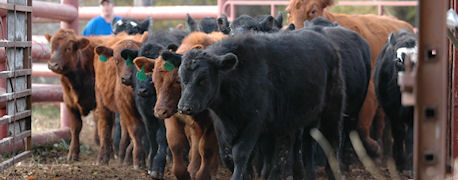February 12, 2014

Jim Krantz, South Dakota State University Extension cow-calf field specialist, says are 11 things that should be a cow lease/share agreement.
1. The split: 70-30 has been a common split recently, with the cow owner receiving 30% of the calves and all the cull cow revenue. But each agreement is unique. "Discussions begin with the identification of the contributions each party will provide in this cow partnership," he says. From the owner's (lessor) viewpoint, those contributions usually include the cows themselves along with an accompanying health program and the bull power to service the cows, Krantz says. Inputs are typically listed as contributions from the lessee and might include feed, grazing acres, labor, equipment and facilities. Add up the value of contribution from each side will serve as a guide to what's a fair split of the calf crop.
2. Start date/end date: Typical share agreements run from October to October, but should be specifically documented in writing, regardless of what it is. That timeline should also include a date when the owner needs to take responsibility for his share of the calves.
3. Bred cows: Cow should be guaranteed to be pregnant when they arrive, if using an October start date.
4. Cow numbers: On multi-year share agreements is there a "minimum number" of cows guaranteed by the owner? How are replacements handled?
5. Pregnancy test: Cows should be pregnancy-tested each fall to document non-bred individuals and eliminate winter feed costs involved with wintering them.
6. Heifer development and/or backgrounding: If calves are to be backgrounded or heifers developed, a separate agreement needs to be made where the owner of the calves pays for the feed costs and yardage expenses. Combining this enterprise with the cow lease makes determining an equitable split of the calf crop much more difficult.
7. Cow body condition score: Herd body condition score should be assigned to cows when care for them is transferred, so both parties are aware of the expectations for cow condition if the agreement is terminated at some point later. Use of a third party to assist both parties in that process is recommended.
8. Death loss verification: Procedures utilized by insurance companies to verify cow death loss can be adopted and included in the cow share agreement. That typically involves the services of a licensed veterinarian with the expense normally assigned to the cow owner.
9. Health programs: Expectations for herd health, cows and calves, should be outlined in the agreement as well. Unique marketing programs sometimes have limitations on vaccines or treatment protocols making it essential to list them so they can be complied with. In addition, both party's veterinarians should be consulted for input, especially if the new environment is significantly different than the present one.
10. Creep feeding: Creep feeding calves for some is a standard practice while other cattle producers prefer to forgo that management scheme. That decision should also be a part of the agreement. If it is utilized, creep expenses are normally shared in the same percentage as calf value is.
11. Method of division: Next to agreeing on sharing of calf value, how that share is to be divided may deserve some serious consideration. When all the calves are sold at public auction, the process is simple mathematics. Where calves are designated for owner/operator possession, the process is something to be discussed thoroughly as the agreement is being prepared.
All agreements should be in writing. "While many business arrangements have been done on a handshake to the benefit of both parties, there are numerous examples of verbal agreements that have failed because the parties couldn't agree on exactly what had been agreed to," Krantz says. "Having things in writing goes a long way to eliminate those problems."
For more information, see the North Central Farm Management Extension Committee's Beef Cow Rental Arrangements.
You May Also Like




